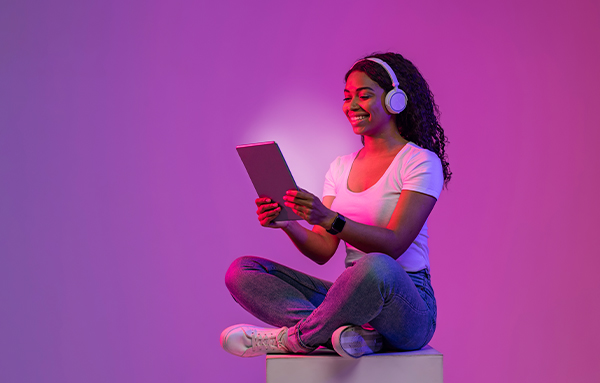
Whether you’re a small business owner, a digital creator, or a seasoned developer, staying on top of emerging practices is crucial for keeping websites engaging, intuitive, and relevant.
These changes necessitate a proactive approach to consent management in lead generation efforts.
While grids and perfectly aligned sections have long been standard, asymmetrical layouts and overlapping elements in web design are becoming more popular.
This approach creates a dynamic, unpredictable feel that engages visitors.
Expect to see organic asymmetric shapes in web design 2025, where backgrounds, images, or text blocks aren’t confined to rigid rectangles.
For designers and developers who once believed that strict symmetry was mandatory, this trend is a clear sign that creativity and experimentation are back in full swing.
Another major trend is the adoption of biophilic design examples in web design, incorporating nature-inspired patterns, textures, and colors into digital interfaces.
Rounded, leaf-like shapes and earthy tones reflect a desire for harmony between technology and the natural world.
As environmental consciousness continues to rise, sustainable web design trend digital design is gaining traction.
This involves optimizing your site to reduce data transfer, using clean hosting solutions, and minimizing unnecessary visual elements.
A “lighter” website not only improves performance and user experience but also reduces its carbon footprint.
Consumers are growing more sophisticated about color psychology, and brands are following suit.
From vivid, futuristic palettes to subtle, minimalism with a twist web design approaches, color choices for web design in 2025 will revolve around clarity, inclusivity, and brand authenticity.
For instance, designers might experiment with warm gradients to evoke comfort, or neon contrasts for cutting-edge appeal.
When combined with organic shapes in web design 2025, the result can be both visually striking and user-friendly.
While responsive web design has been standard for years, its evolution continues.
In 2025, websites must not only adjust to different screen sizes but also consider new contexts—voice assistants, smartwatches, and even virtual reality headsets are becoming mainstream.
Thus, responsive design will transcend basic screen resizing to ensure that the entire user journey is fluid, no matter the device.
Ecommerce web design is getting a major overhaul thanks to AI, AR try-on experiences, and more intuitive checkout processes.
Consumers expect seamless, personalized shopping, and brands are leveraging everything from web app design to integrated ChatGPT-like features to meet these demands.
n 2025, UX isn’t just about good navigation or fast loading times.
It’s about web design inspiration that satisfies emotional needs, fosters inclusivity, and accounts for accessibility from the ground up.
Features like button group ideas web design—where multiple calls-to-action are grouped logically—give users clear pathways to explore.
Classic minimalism is evolving to include small bursts of color or playful graphics.
This so-called minimalism with a twist web design can be more inviting than stark minimalism while still emphasizing clarity.
Collage web design and scrapbooking design trends are likely to influence 2025 styles.
This mix-and-match look uses layered images, text, and shapes for an artful yet organized feel—ideal for blogs, creative portfolios, and cutting-edge landing pages.
A big part of web design and web development in 2025 will be an increased emphasis on performance-based SEO web design.
Websites should load quickly on all devices and be structured for easy crawling by search engines.
Additionally, data security is non-negotiable; everything from database encryption to secure payment gateways will become table stakes.
“Web design vs web development” has long been a debate, but in 2025, the lines continue to blur.
Designers need to grasp code-friendly concepts, while developers gain aesthetic awareness.
This synergy ensures that what looks good also performs well.
In an era where technology changes almost daily, web design as a service offers businesses an ongoing partnership rather than a one-time product.
Designers need to grasp code-friendly concepts, while developers gain aesthetic awareness.
Design agencies and freelancers provide continuous updates, maintenance, responsive web design improvements, and rebranding efforts to keep websites fresh.
Benefits of "As a Service" Models:
Whether you’re focused on design trends for 2025 in web design and graphic design or looking to leverage artificial intelligence for web design, the future is all about synergy—synergy between aesthetics, technology, user needs, and sustainability.
By embracing these new web design trends 2025, you ensure that your website or app not only stands out but also delivers meaningful value to your audience.
As you plan your next redesign or start a fresh project, remember to factor in web design colors 2025, incorporate organic asymmetric shapes in web design 2025, and explore biometric-driven design future web design if it fits your niche.
Keep performance, security, and SEO at the forefront, and don’t be afraid to blur the lines of web design vs web development—collaboration is key in building something truly remarkable.
In short, the year 2025 is shaping up to be a milestone for digital experiences, combining cutting-edge technology with innovative design philosophies.
By staying attuned to these emerging trends, you’ll craft more engaging, efficient, and forward-thinking online experiences that captivate users from the moment they arrive on your site.
Yes. Custom designs can better reflect your brand identity and user experience goals, helping you stand out from competitors who rely on generic templates.
It depends on your target audience and budget. VR/AR can create immersive experiences, but they require specialized development and may only make sense if your users can benefit from interactive product demos or immersive storytelling.
Absolutely. Subtle animations—such as buttons that gently move or icons that highlight when hovered—can enhance user engagement without overwhelming the page.
Dark mode is still trending for both aesthetic and energy-saving reasons, so it’s likely to stay relevant, particularly in interfaces aimed at tech-savvy or design-focused audiences.
Yes. Optimizing content for voice search ensures your site is discoverable by users who rely on smart speakers and voice assistants, a trend that continues to rise.
Fabio De Gouveia
"Web design is constantly evolving. Keeping up with trends is crucial."